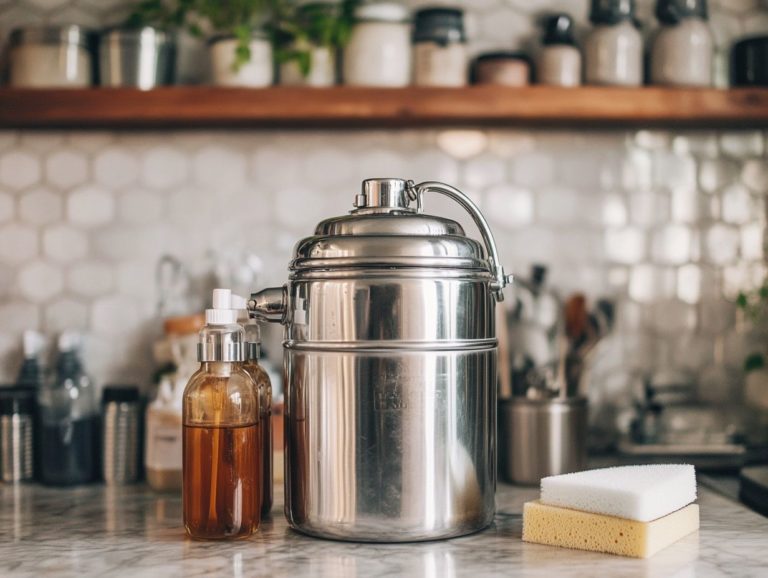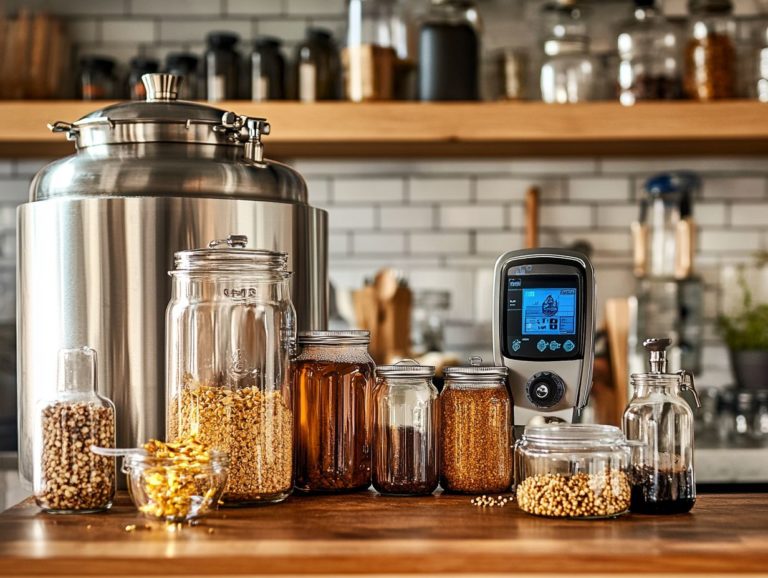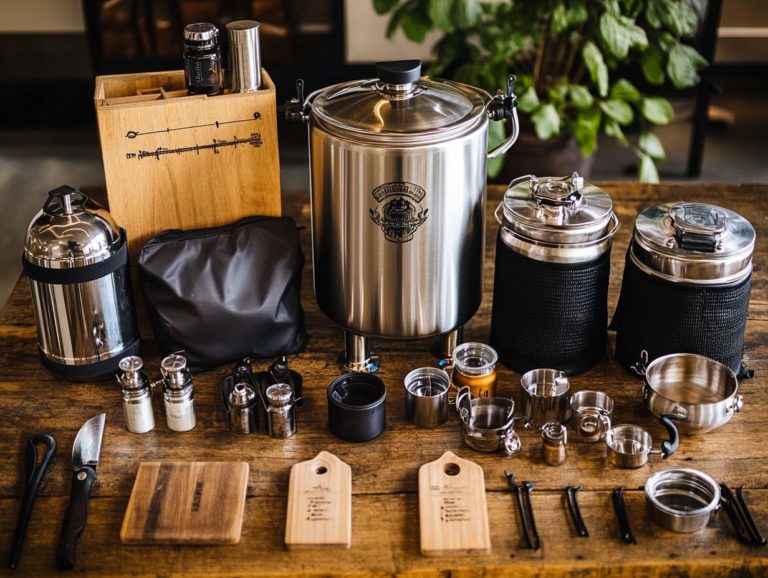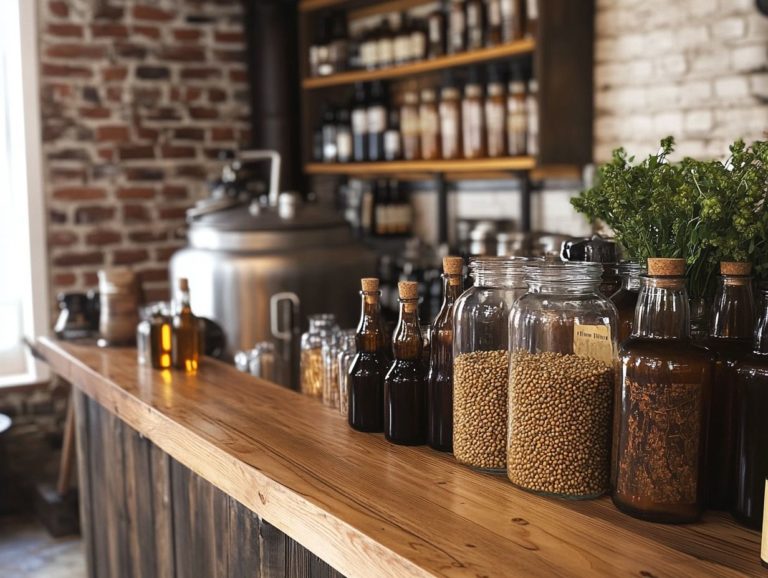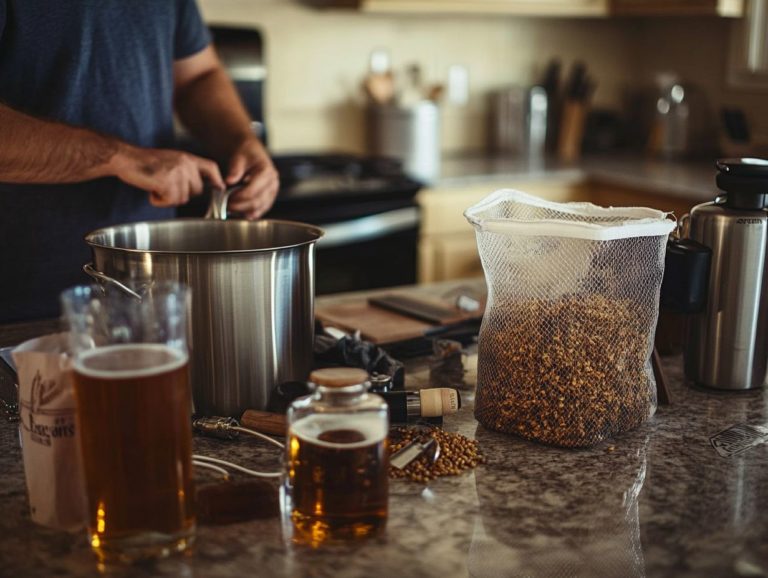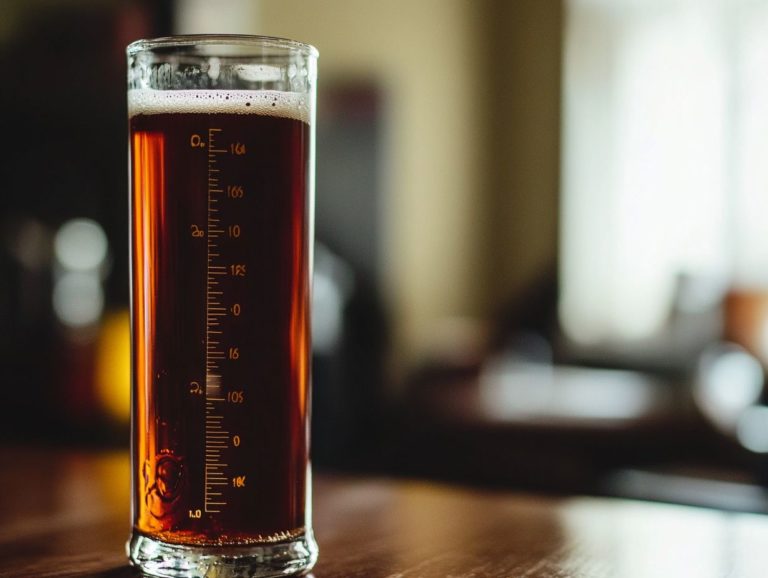Top 10 Must-Have Tools for Home Brewing
Home brewing has experienced a remarkable surge in popularity, drawing in homebrewers and brewing enthusiasts who are eager to create their own distinctive brews right in the comfort of their kitchens. Whether you consider yourself a novice or a seasoned brewer, having the right brewing tools in your brewing kit can significantly enhance your brewing experience. Dive into the top 10 essential tools that every home brewer should keep on hand, along with the numerous benefits of brewing at home, common pitfalls to steer clear of, and valuable tips for refining your skills. Prepare to elevate your brewing game to new heights! Let s dive in and explore these must-have tools together!
Contents
- Key Takeaways:
- 1. Brewing Kettle and Brewing Paddles
- 2. Fermenter
- 3. Hydrometer
- 4. Thermometer
- 5. Bottle Capper
- 6. Bottle Filler
- 7. Sanitizer
- 8. Wort Chiller
- 9. Auto-Siphon and Bottle Capper
- 10. Airlock and Hydrometer
- What Is Home Brewing and Why Is It Popular?
- How Can One Get Started with Home Brewing? Essential Brewing Kits and Tools
- What Are Some Tips for Choosing the Right Home Brewing Tools? Exploring Brewing Systems and Quality Equipment
- How Can One Improve Their Home Brewing Skills? Exploring Brewing Innovations and Aspirations
- Frequently Asked Questions
- What are the top 10 must-have brewing tools for home brewing?
- Why is a brewing kettle important in home brewing?
- What is the purpose of fermentation vessels in home brewing?
- Why is an airlock necessary for beer brewing?
- What is the role of a hydrometer in beer fermentation?
- What are the benefits of using an auto-siphon in beer making?
- Why is sanitizing equipment essential for home brewing?
- What type of bottles should be used for beer brewing?
- Why is a bottle capper necessary for beer making?
- How often should a bottle brush be used in beer making?
Key Takeaways:
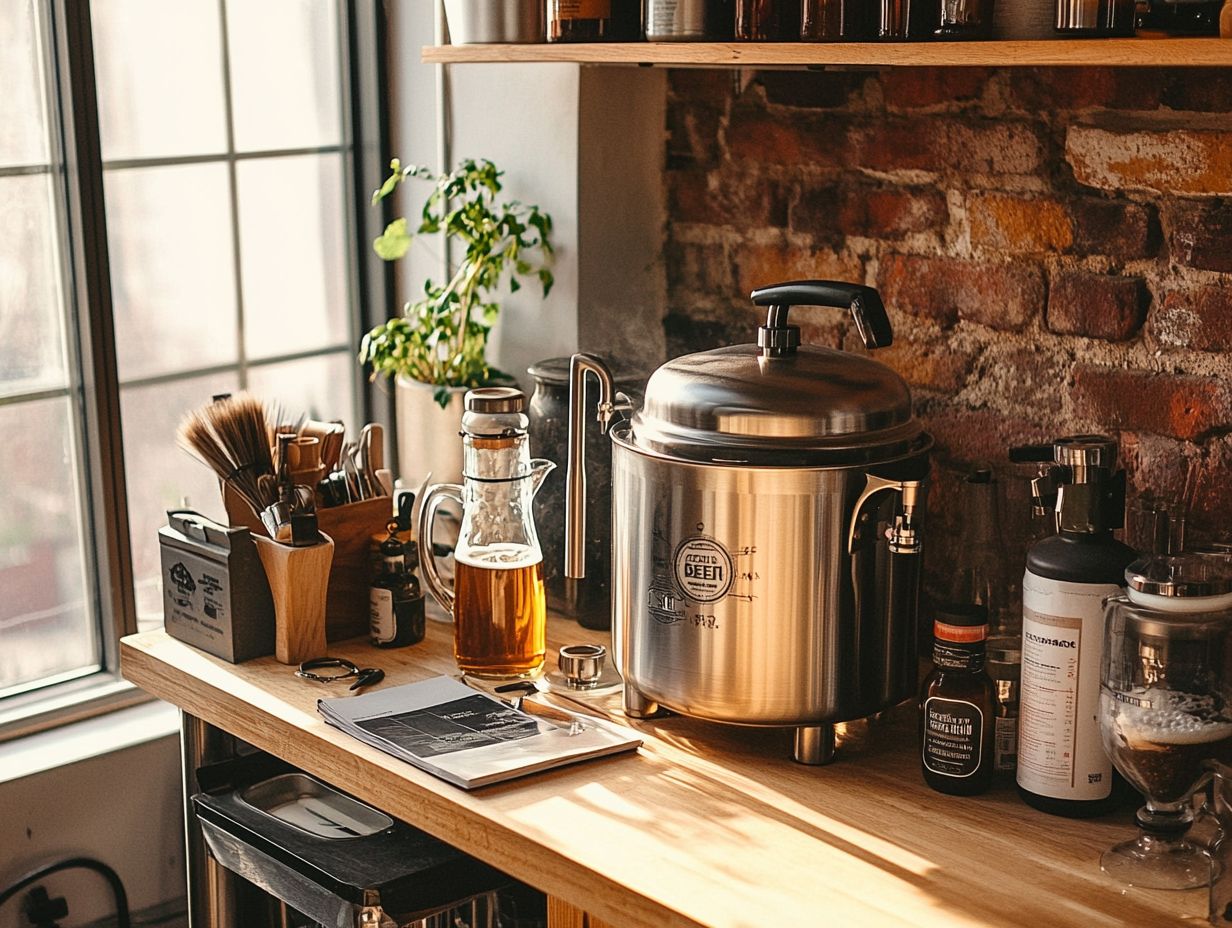
- Invest in a brewing kettle, fermenter, and hydrometer for a successful home brewing process and to track specific gravity.
- Ensure accuracy with a thermometer and use a bottle capper and filler for bottling your brew.
- Sanitize all equipment for a clean and safe brewing environment, and use a wort chiller and auto-siphon for wort chilling, ease, and efficiency.
1. Brewing Kettle and Brewing Paddles
A brewing kettle is a critical tool for any homebrewing aficionado, acting as the primary vessel for boiling wort and playing a pivotal role in the brewing process. This choice can significantly shape the quality of your final beer and elevate your overall brewing experience.
Today s market offers a diverse range of brewing kettles, from budget-friendly aluminum options to premium stainless steel models. Each type comes with its own set of advantages. Stainless steel, in particular, stands out for its durability and resistance to rust and corrosion, promising a long lifespan for those who brew frequently. Many of these kettles come with features like built-in thermometers and ball valves, which streamline your brewing process and boost efficiency.
The material and design of your kettle can influence not only the ease of your brewing but also the characteristics of various beer styles, affecting heat retention and distribution. For anyone truly committed to home brewing, investing in quality equipment will supercharge your brewing success and is essential for achieving consistent results while unlocking the full potential of your brewing endeavors.
2. Fermenter
The fermenter plays a pivotal role in your homebrewing journey, offering a controlled environment for yeast fermentation. Here, malt, hops, and yeast come together to transform sugars into alcohol, giving rise to a variety of beer styles.
You ll find different types of fermentation vessels, including plastic buckets, glass carboys, and stainless steel fermenters, each boasting its own set of benefits and drawbacks. Their capacities can vary significantly, ranging from a single gallon to several barrels. This variance affects not only the volume of beer you can produce but also how effectively you can manage temperature during fermentation.
For example, a larger fermenter may help maintain a more stable temperature thanks to its thermal mass, while smaller vessels can facilitate quicker wort chilling and temperature adjustments. When selecting the right fermenter for your specific beer recipes, consider factors like how easy it is to clean, the type of beer you want to brew, and whether you plan to dry hop or incorporate fruit.
Understanding these elements is essential to enhancing your fermentation process and achieving the results you desire.
3. Hydrometer
A hydrometer is an essential companion for homebrewers, providing you with the ability to measure specific gravity the measure of the density of a liquid compared to water indicating the sugar content in the wort and track the fermentation process. This tool is crucial for achieving optimal brewing efficiency and ensuring your beer has the desired alcohol content.
By accurately assessing specific gravity before fermentation, you can determine the potential alcohol level and gauge the amount of sugar present in the wort. Once fermentation is complete, measuring again reveals how much sugar has transformed into alcohol, serving as a clear indicator of whether the process has finished.
It s important to steer clear of common pitfalls, such as taking measurements at different temperatures without making the necessary adjustments, as this can lead to skewed results. Consistency in timing your measurements is vital; it can significantly influence the final product.
By understanding these changes, you gain finer control over your brewing process, elevating your craft brewing skills and brewing aspirations to new heights.
4. Thermometer
A reliable thermometer is essential in your homebrewing journey. Maintaining the correct brewing temperature and fermentation temperature during mixing grains with water to create the base for your beer and fermentation can significantly influence the flavor profile and quality of the beer you produce.
In the brewing realm, you ll find several effective thermometer types, including digital, infrared, and traditional dial thermometers. Each plays a unique role throughout the brewing process. To wield these tools effectively, you need to understand when to measure temperatures. Precise readings are vital during critical stages like mixing and fermentation.
The importance of temperature control cannot be overstated, especially given its impact on yeast activity. Higher temperatures may accelerate fermentation, while lower temperatures often promote more nuanced flavors.
Therefore, an informed brewer recognizes that optimal temperature management not only enhances the brewing experience but also guarantees a well-balanced and satisfying final product in your beer making.
5. Bottle Capper
A bottle capper is a critical tool for you as a homebrewer. It allows you to package your beer with precision. With a secure seal, your bottles will maintain their freshness and carbonation during storage, keeping that delightful brew just as you intended.
You ll find various types of bottle cappers on the market, including handheld, bench, and electric options. Each type has its own set of features tailored to different brewing scales and personal preferences.
For example, a handheld capper is compact and ideal for small batches. In contrast, a bench capper provides greater leverage and consistency, making it a perfect choice for larger quantities.
Regardless of which capper you choose, effective bottling hinges on thorough preparation. Before diving in, it s crucial to sanitize all your equipment to ward off any contamination that could spoil your hard work. Achieving a proper seal is essential; it not only ensures that fermentation is at its best, promoting optimal carbonation, but it also significantly influences your beer’s shelf life. This way, every sip remains as delightful as the first.
6. Bottle Filler
A bottle filler is an essential accessory in your home brewing toolkit, enabling you to fill bottles with minimal disturbance. This not only preserves the carbonation and clarity of your beer but also ensures safety during the bottling process.
You’ll find various types of bottle fillers, each designed with unique mechanisms to suit different brewing styles.
For example, gravity fillers rely on the natural flow of liquid. On the other hand, counter-pressure fillers introduce gas to maintain carbonation levels as you fill. If you’re looking to streamline the process, automatic bottle fillers can make your life a lot easier, reducing the labor involved.
The importance of using a bottle filler cannot be overstated. It plays a crucial role in preventing oxidation and contamination two factors that can drastically impact your final product. By effectively implementing these tools, you elevate your brewing experience, resulting in superior quality beer that truly captures the intended flavors and aromas.
7. Sanitizer
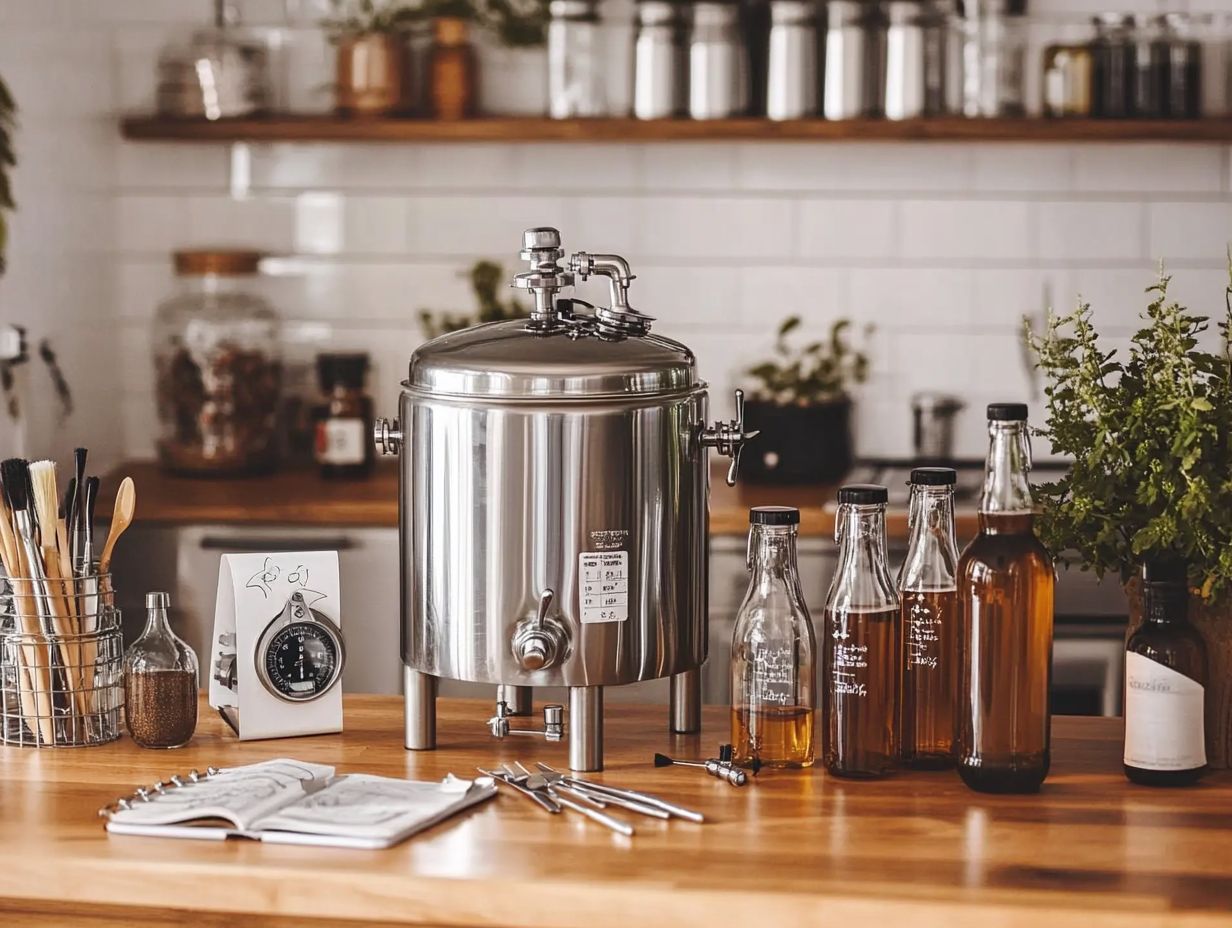
Sanitizing your equipment is absolutely crucial in home brewing. It safeguards your beer from unwanted bacteria and wild yeast that could taint the brew, ensuring that the fermentation process goes off without a hitch. This ensures that the final product is completely safe for you to enjoy.
Imagine each step in the sanitization process as your secret weapon for brewing perfection! As a home brewer, you have a range of sanitizing options at your disposal, with popular choices like iodophor, Star San, and even plain bleach.
Each of these sanitizers is designed to eradicate harmful microorganisms. However, they must be used according to the manufacturer’s instructions to be truly effective. Best practices for sanitizing start with thoroughly cleaning all your equipment before applying any sanitizer, allowing it sufficient time to work its magic.
Don t risk your brew! Neglecting these protocols can lead to disastrous flavors, spoilage, or even microbial infections in your beer, which can seriously compromise your enjoyment of the final product and your brewing adventures.
8. Wort Chiller
A wort chiller is a critical tool for you as a homebrewer, enabling you to cool the wort quickly after boiling. This rapid cooling is crucial to maintain the optimal fermentation temperature and ward off contamination from pesky ambient bacteria.
You ll find a variety of chiller types available immersion, counterflow, and plate chillers. Each type has unique advantages that suit different brewing setups. For instance, an immersion chiller is incredibly user-friendly; simply submerge it in the hot wort and let cold water flow through the coils. On the flip side, counterflow and plate chillers boast greater efficiency, delivering faster chilling times that can be a game-changer for wort chilling.
Maintaining proper temperature control during brewing is essential, as it has a direct impact on yeast performance. Quick chilling not only boosts fermentation activity but also enhances beer clarity by encouraging unwanted particles to settle. Ultimately, selecting the right wort chiller can profoundly influence the quality of your final brew.
9. Auto-Siphon and Bottle Capper
An auto-siphon is a critical ally for you as a homebrewer, effortlessly simplifying the transfer of liquid between vessels while keeping oxygen at bay. This not only safeguards your brewing process but also ensures your beer maintains its integrity during bottling or kegging. Coupling it with a bottle capper enhances your brewing efficiency.
Utilizing an auto-siphon significantly cuts down on the effort and time required for siphoning compared to traditional methods, which often involve awkward positions and the risk of spills. This device creates an effective seal that allows for smooth and controlled flow, making it easier for you to handle your brew with finesse. Understanding specific gravity measurements with a hydrometer can further refine your brewing process.
By preventing oxidation during transfers, it elevates the overall flavor and quality of your finished product. However, watch out for common pitfalls when using an auto-siphon, such as inadequate priming or introducing air bubbles. To avoid these issues, make sure the siphon tube is properly submerged and execute the transfer gently.
Keep in mind that the ultimate goal is to preserve that delightful, fresh taste. Being mindful of your technique can truly make all the difference in your brewing experience.
10. Airlock and Hydrometer
An airlock is an essential device in home brewing that plays a crucial role in your fermentation process. It allows carbon dioxide to escape while keeping contaminants at bay, ensuring both safety and success in your brewing endeavors. Monitoring specific gravity with a hydrometer during this stage is also crucial, as it helps you gauge fermentation progress.
As an aspiring brewer, it s vital for you to understand the different types of airlocks available, such as the S-shaped airlock and the three-piece airlock. Each design comes with its own set of advantages, whether it’s ease of use or enhanced reliability during fermentation.
To set up your airlock correctly, fill it with a sanitizer solution typically water or vodka to create a barrier against microorganisms. The airlock is important because it helps maintain an optimal fermentation environment, allowing gases to escape while keeping harmful bacteria out.
Keep your airlock in check to avoid contamination that can ruin your hard work! Over-tightening it or neglecting regular cleaning can lead to problems like contamination, clogged air passages, or even fermentation stalls that could jeopardize the quality of your final product.
What Is Home Brewing and Why Is It Popular?
Home brewing is truly the art and science of creating beer right in your own kitchen. Here, you can experiment with various brewing techniques and equipment to craft unique beer recipes. This pursuit has captured the hearts of many enthusiasts eager to dive into the world of craft brewing and connect with a vibrant community of fellow brewers.
The tradition of home brewing stretches back centuries. It is rooted in ancient civilizations where beer was often crafted within households. While industrialization once ushered in an era of mass-produced beers, the craft movement has revived the passion for this time-honored practice. Many are drawn to home brewing not just for the joy of creating with diverse ingredients like malt, hops, and yeast, but also for the friendship it fosters among fellow brewers.
Sharing your personal creations at local meet-ups or competitions can cultivate friendships and inspire the exchange of knowledge. This hobby transcends mere beer-making; it s about forging bonds within a community that celebrates creativity and collaboration.
Benefits of Home Brewing
Home brewing offers you a plethora of benefits. You can create custom beers that perfectly suit your taste and master brewing techniques.
Additionally, you have the potential to save money while working with high-quality equipment to craft superior beverages. Exploring different beer styles adds depth to your brewing experience.
- Create custom beers.
- Master brewing techniques.
- Save money while enjoying quality.
Beyond the sheer joy of perfecting your brew, you ll also find yourself immersed in a rich tapestry of flavors and aromas. This journey is your exciting invitation to explore a variety of ingredients and techniques, providing an exhilarating creative outlet.
Not only will your brewing skills flourish, but you ll also cultivate a sense of community as you connect with fellow enthusiasts in local clubs. There, you can share tips, exchange recipes, and even participate in friendly competitions.
As you engage in this fulfilling hobby, you’ll gain a profound understanding of the brewing process from selecting the finest malts and hops to grasping the complexities of fermentation, which is the process where yeast converts sugars into alcohol. Each element plays a crucial role in transforming basic ingredients into a delightful craft beer.
In dedicating yourself to home brewing, you ll uncover not just a way to save money but an enriching experience that links you with like-minded individuals and deepens your appreciation for this time-honored craft.
Common Mistakes to Avoid in Home Brewing
Home brewing is a gratifying pursuit, but it s not without its common pitfalls that can dampen the experience. Neglecting sanitization or miscalculating fermentation temperatures can lead to off-flavors and batches that fall short of expectations. Ensuring proper brewing safety practices is also crucial.
As a novice brewer, you might underestimate the significance of these factors, which could result in frustration and disappointment. One of the biggest traps is failing to maintain proper sanitization, as this can invite unwanted bacteria into your brew, ultimately compromising the final product. Keeping a close eye on fermentation temperatures is equally vital; any fluctuations can stress the yeast and yield undesirable flavors. Proper fermentation temperature control is essential for successful beer fermentation.
- Neglecting sanitization.
- Miscalculating fermentation temperatures.
- Failing to measure ingredients meticulously.
Meticulous measurement of ingredients is essential for achieving that perfect taste and quality, as even tiny discrepancies can drastically alter the outcome. By paying attention to these crucial aspects, you can significantly enhance your brewing success and truly savor the fruits of your labor.
Start brewing today and join the fun!
How Can One Get Started with Home Brewing? Essential Brewing Kits and Tools
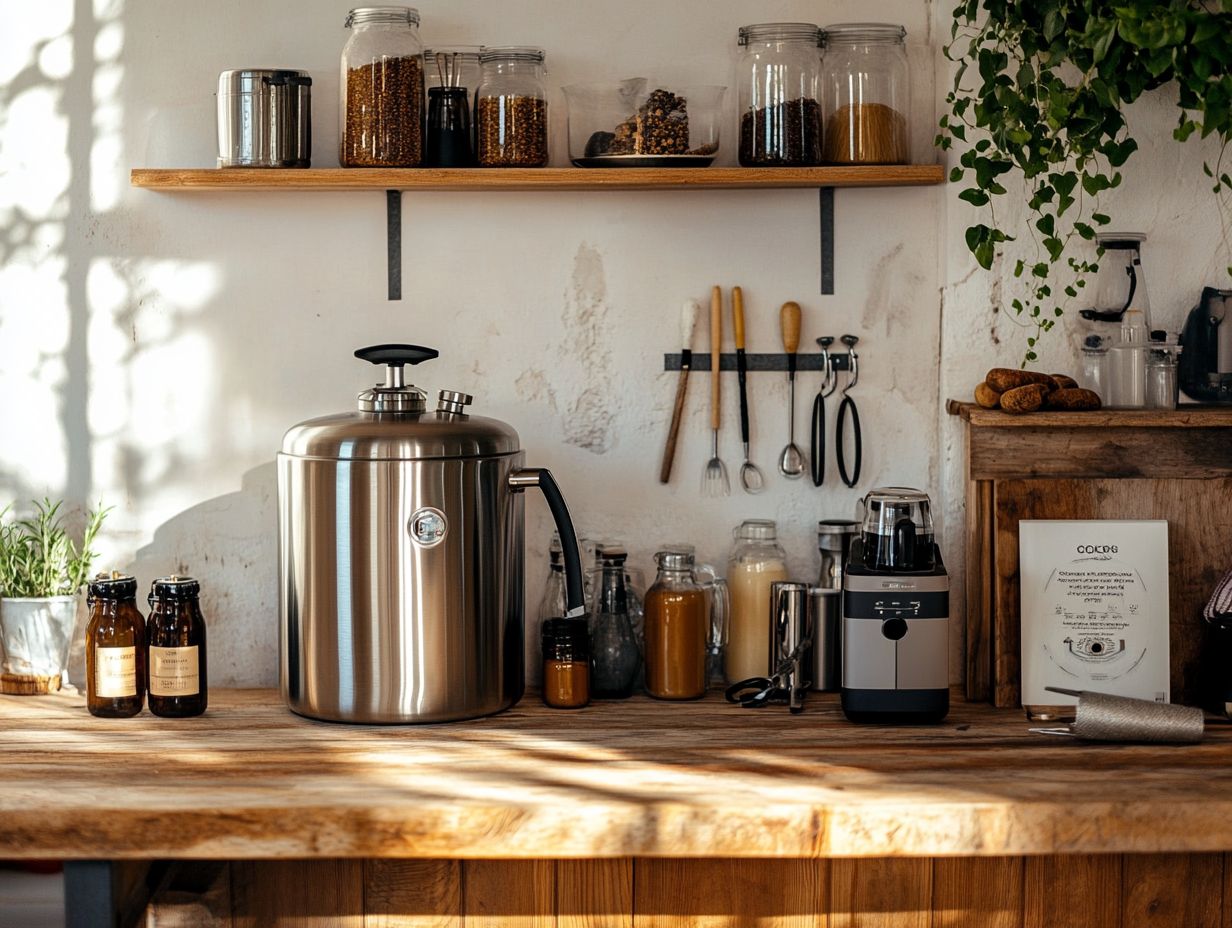
Embarking on the journey of home brewing is an exhilarating experience. It begins with selecting a brewing kit, gathering essential materials, and following instructions to craft your first batch of beer.
Understanding key brewing instructions and tools like fermentation vessels (containers where brewing takes place) and brewing paddles is important. This adventure ignites your creativity and invites you to explore a world of flavors and styles.
For beginners, a comprehensive starter kit that includes essential equipment like fermentation vessels, airlocks, and bottles will set you up for success. Companies like Northern Brewer, Mr. Beer, and Brooklyn Brew Shop are great places to buy these kits.
Make sure you have key ingredients on hand: malt extract, hops, yeast, and brewing sugar. To deepen your knowledge, utilize online resources and local brewing classes that provide valuable techniques and insights.
Join the buzz of a local brewing community or participate in online forums. This can provide support, advice, and a sense of camaraderie, enriching your brewing experience.
What Are Some Tips for Choosing the Right Home Brewing Tools? Exploring Brewing Systems and Quality Equipment
Choosing the right home brewing tools is essential for crafting a successful brewing experience. A combination of essential tools and quality equipment can elevate both the brewing process and the final beer product.
As you start your home brewing journey whether you’re a budding enthusiast or a seasoned artisan recognizing which tools are critical can transform your experience. Begin with a sturdy brewing kettle, which serves as the cornerstone of your brewing endeavors.
Next, consider fermenters. These are vital for providing the yeast an ideal environment to work its magic. Stainless steel fermentation tanks are highly recommended.
Don’t underestimate the importance of reliable sanitizing equipment. Cleanliness is crucial in brewing to avoid unwanted flavors. Invest in high-quality tools to refine your techniques and ensure every brew is enjoyable to create and savor.
How Can One Improve Their Home Brewing Skills? Exploring Brewing Innovations and Aspirations
Improving your home brewing skills is an exciting journey of experimentation and learning. It combines insights from the brewing community with a commitment to refining your processes through practice and feedback.
To elevate your brewing experience, immerse yourself in local brewing clubs where enthusiasts exchange stories and techniques. Connecting with fellow brewers can inspire passion and new ideas.
Attend workshops to explore different brewing techniques. This hands-on learning allows you to grasp the nuances of various methods. Don’t hesitate to experiment with different beer styles, from rich stouts to hoppy IPAs; this will expand your palate and deepen your understanding of brewing.
Tap into resources like online forums and local brewing supply shops. These are treasure troves of knowledge, providing guidance on brewing tools, ingredients, and quality equipment.
Frequently Asked Questions
What are the top 10 must-have brewing tools for home brewing?
The top 10 must-have tools for home brewing include a brewing kettle, fermenter, airlock, thermometer, hydrometer, auto-siphon, sanitizer, bottles, bottle capper, and a bottle brush. These essential tools are key to a successful brewing experience.
Why is a brewing kettle important in home brewing?
A brew kettle is important in home brewing as it is used to boil the wort, which is the liquid extracted from malted grains. This boiling process helps to release the flavors and aromas of the grains, making it a crucial step in the brewing process.
What is the purpose of fermentation vessels in home brewing?
Fermentation vessels are used to store and ferment the wort, the first stage in the conversion of sugars into alcohol. They keep the wort in a controlled environment during fermentation.
Why is an airlock necessary for beer brewing?
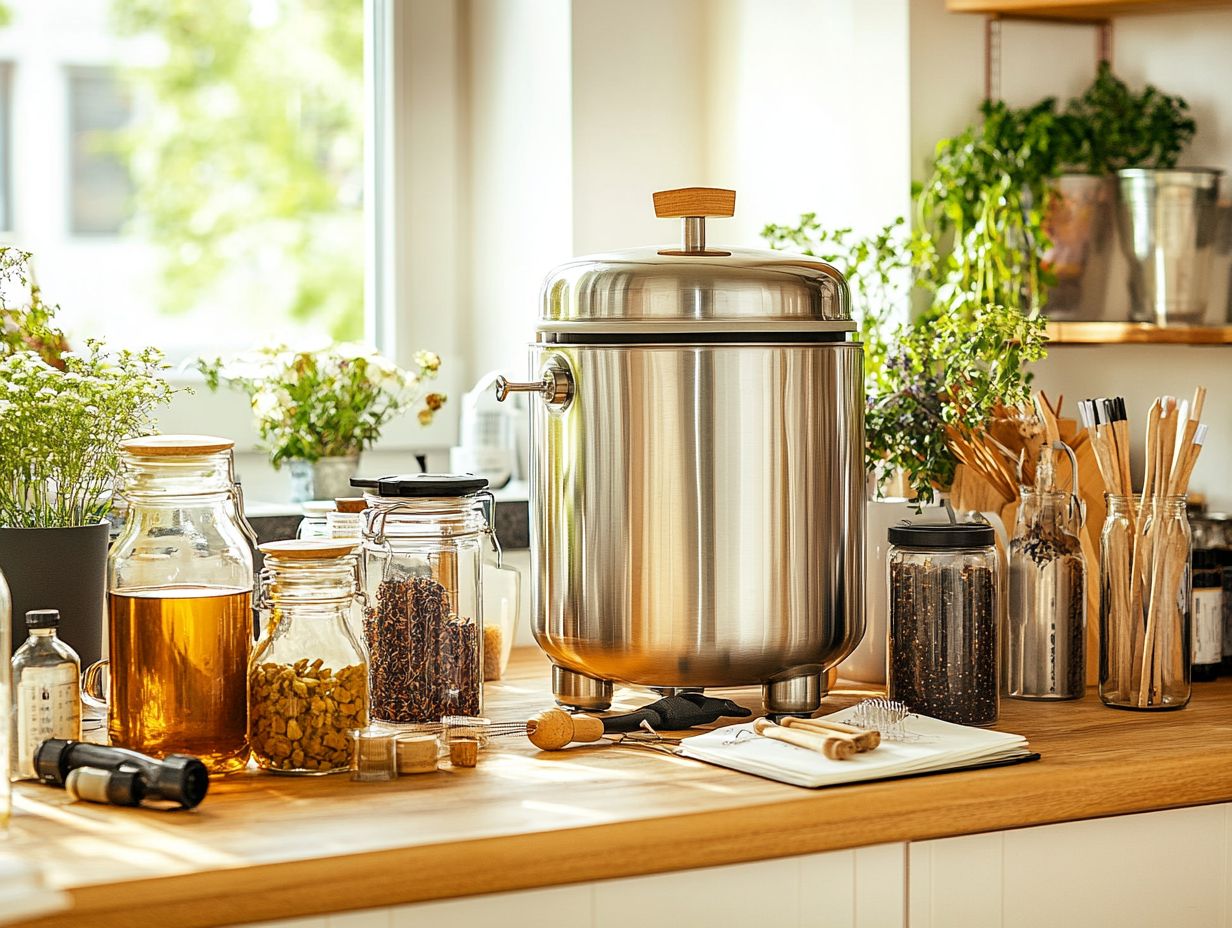
An airlock is essential for home brewing as it allows for the release of carbon dioxide during fermentation. This helps to prevent pressure buildup in the fermenter and can prevent potential explosions.
What is the role of a hydrometer in beer fermentation?
A hydrometer is a tool used to measure the density of the wort, indicating the sugar content. This is essential for monitoring fermentation temperature and tracking the yeast activity, which helps determine the alcohol content and the progress of fermentation.
What are the benefits of using an auto-siphon in beer making?
An auto-siphon is a game-changer! It lets you transfer your delicious fermented beer without disturbing the sediment, giving you that clear, clean brew you crave.
Why is sanitizing equipment essential for home brewing?
Sanitizing is crucial in home brewing as it eliminates any bacteria or microbes that could contaminate your beer. This ensures that the final product is safe to consume and has a longer shelf life.
What type of bottles should be used for beer brewing?
Glass bottles are the most commonly used for beer brewing as they are sturdy, easy to clean, and do not react with the beer. Ensure you also use proper brewing materials to preserve the beer quality. However, some brewers opt for plastic bottles or cans for their convenience.
Why is a bottle capper necessary for beer making?
You ll love using a bottle capper for your home brewing it makes sealing your beer a breeze! This tool helps maintain the carbonation and freshness of the beer, ensuring a better drinking experience.
How often should a bottle brush be used in beer making?
A bottle brush should be used after every use to clean out any residue or sediment in the bottles. This is a critical part of maintaining brewing safety and efficiency. It helps prevent contamination and ensures that the bottles are ready for the next use.

